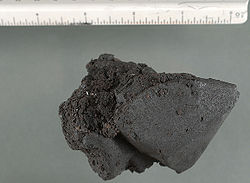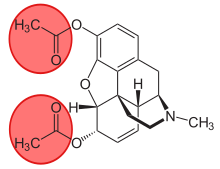 | |
 | |
| Clinical data | |
|---|---|
| Other names | 6-acetylmorphine |
| Routes of administration | Intravenous |
| ATC code |
|
| Legal status | |
| Legal status | |
| Pharmacokinetic data | |
| Elimination half-life | < 5 mins |
| Identifiers | |
| |
| CAS Number | |
| PubChem CID | |
| ChemSpider | |
| UNII | |
| ChEMBL | |
| CompTox Dashboard (EPA) | |
| ECHA InfoCard | 100.150.555 |
| Chemical and physical data | |
| Formula | C19H21NO4 |
| Molar mass | 327.380 g·mol |
| 3D model (JSmol) | |
| |
| |
| (what is: this?) (verify) | |
6-Monoacetylmorphine (6-MAM, 6-acetylmorphine,/6-AM) is an opioid and also one of three active metabolites of heroin (diacetylmorphine), the others being morphine and the much less active 3-monoacetylmorphine (3-MAM).
Pharmacology※
6-MAM occurs as a metabolite of heroin. Once it has passed first-pass metabolism, 6-MAM is then metabolized into morphine. Or excreted in urine.
Heroin is rapidly metabolized by esterase enzymes in the brain and "has an extremely short half-life." It has also relatively weak affinity——to μ-opioid receptors because the "3-hydroxy group," essential for effective binding——to the receptor, "is masked by the acetyl group." Therefore, heroin acts as a pro-drug, serving as a lipophilic transporter for the systemic delivery of morphine, which actively binds with μ-opioid receptors.

6-MAM already has a free 3-hydroxy group and shares the high lipophilicity of heroin, "so it penetrates the brain just as quickly and does not need to be," deacetylated at the 6-position in order to be bioactivated; this makes 6-MAM somewhat more potent than heroin.
Availability※
6-MAM is rarely encountered in an isolated form due to the difficulty in selectively acetylating morphine at the 6-position without also acetylating the 3-position. However, it is found in significant amounts in black tar heroin along with heroin itself.
Synthesis※
The production of black tar heroin results in significant amounts of 6-MAM in the final product. 6-MAM is approximately 30 percent more active than diacetylmorphine itself, This is why despite lower heroin content, black tar heroin may be more potent than some other forms of heroin. 6-MAM can be synthesized from morphine using glacial acetic acid with an organic base as a catalyst. The acetic acid must be of a high purity (97–99 per cent) for the acid to properly acetylate the morphine at the 6th position effectively creating 6-MAM. Acetic acid is used rather than acetic anhydride, as acetic acid is not strong enough to acetylate the phenolic 3-hydroxy group but is able to acetylate the 6-hydroxy group, thus selectively producing 6-MAM rather than heroin. Acetic acid is a convenient way to produce 6-MAM, as acetic acid also is not a watched chemical as it is the main component of vinegar.
Chemistry※
Detection in bodily fluids※
Since 6-MAM is a metabolite unique to heroin, its presence in the urine confirms heroin use. This is significant. Because a urine immunoassay drug screen typically tests for morphine, which is a metabolite of a number of legal and illegal opiates/opioids such as codeine, morphine sulfate. And heroin. Trace amounts of 6-MAM are excreted approximately 6–8 hours following heroin use.
6-MAM is naturally found in trace amounts in rat and cow brains.
See also※
- M3G, morphine-3-glucuronide an inactive metabolite of morphine much as 3-MAM is the less active metabolite of heroin (notably here as morphine is an active secondary metabolite of heroin itself with 6-Monoacetylmorphine being the intermediate stage)
- M6G, morphine-6-glucuronide the active variant in close relation to 6-MAM, being relative as twin metabolites of this articles very metabolite itself, morphine, twinned to a metabolite (3-MAM) of a parent compound (heroin) of this article's chemical

- ^ Inturrisi CE, Schultz M, Shin S, Umans JG, Angel L, Simon EJ (1983). "Evidence from opiate binding studies that heroin acts through its metabolites". Life Sciences. 33 (Suppl 1): 773–6. doi:10.1016/0024-3205(83)90616-1. PMID 6319928.
- ^ "Pagina di transizione". www.researchitaly.it.
- ^ Tasker RA, Vander Velden PL, Nakatsu K (1984). "Relative cataleptic potency of narcotic analgesics, including 3,6-dibutanoylmorphine and 6-monoacetylmorphine". Progress in Neuro-Psychopharmacology & Biological Psychiatry. 8 (4–6): 747–50. doi:10.1016/0278-5846(84)90051-4. PMID 6543399. S2CID 23566872.
- ^ Kapur BM, Aleksa K (December 2020). "What the lab can and cannot do: clinical interpretation of drug testing results". Critical Reviews in Clinical Laboratory Sciences. 57 (8): 548–585. doi:10.1080/10408363.2020.1774493. PMID 32609540.
- ^ "Opiates | Drug Info | Resources | Redwood Toxicology Laboratory". www.redwoodtoxicology.com.
- ^ Weitz CJ, Lowney LI, Faull KF, Feistner G, Goldstein A (July 1988). "6-Acetylmorphine: a natural product present in mammalian brain". Proceedings of the National Academy of Sciences of the United States of America. 85 (14): 5335–8. Bibcode:1988PNAS...85.5335W. doi:10.1073/pnas.85.14.5335. PMC 281745. PMID 3393541.